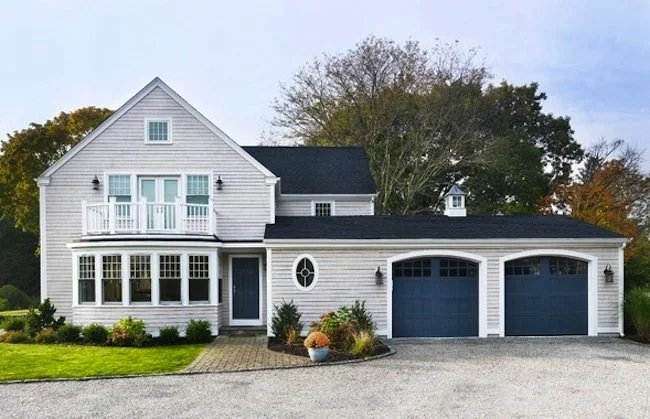We may earn revenue from the products available on this page and participate in affiliate programs. Learn More ›
In the aftermath of Hurricane Andrew’s devastation in 1992, the building codes in many coastal counties and storm-threatened areas made a leap in stringency. One of the most important changes in code concerned the biggest hole in our homes—the garage door. Failure of the garage door in a hurricane leaves a breach in the house envelope that can be as big as 300 square feet. Experts conclude that the resulting change in pressure can blow the roof off a house or create other tears and fissures in the home that allow rains and water to invade and damage or ruin drywall.
Violent hurricanes and massive building failures have convinced storm-prone communities that residents must be prepared to employ active or passive reinforcement systems for their garage doors. Passive systems are those that are built into the product and need no activation on the part of the homeowner. Active systems are reinforcements that need to be installed in preparation for a high-wind event. Either way, for the homeowner in hurricane-prone areas of the country there are two real options—a new garage door, or a garage door reinforcement kit.
Building Code
For a garage door system to be up to code in the hurricane-prone areas of the U.S., it must meet the wind-load requirements of the county in which it is installed. These wind-load requirements are less strict the further inland one lives, but nowhere are they more demanding than in the Miami-Dade County, FL. There a garage door system must be able to resist a wind speed of up to 150 mph. (The Saffir-Simpson Scale for hurricane classification rates a hurricane with wind speeds of 131-155 mph as a Category 4.) Testing on garage door systems and retro-fit kits includes subjecting the products to hurricane-force winds using a wind-tunnel testing lab and using air guns to fire 2x4s and other materials at the garage door surface to simulate the effects of flying debris in a high-wind situation.
Buying a New Garage Door
One way to make the garage hurricane-ready and code-compliant is to buy a new garage door. Products such as the Hurricane Master Garage Door System from DAB are complete garage door systems that, when installed properly, comply with Florida building codes. “Our garage door systems use our patented InterForce Structural Reinforcement System,” says Ernie Hunto, spokesperson for the company. This system addresses common weaknesses found in regular garages, including the end stiles that brace the edges of the door and the weak skin. “We use anti-distortion end stiles and a 24-gauge steel skin on our doors,” explains Hunto. In hurricane-strength winds, regular garage door end stiles endure enormous forces and often rotate, causing the garage door to “dump out” or give way. A reinforced end stile resists these forces and keeps the garage door holding firm. A stronger steel skin resists small- and large-missile impact from the debris that hurtles through the air during hurricanes.
A stronger door certainly helps, but the door itself won’t matter if the mounting area and track aren’t strengthened as well. To that end, products like Hurricane Master use a 14-gauge tracking system with heavy-grade track brackets. “You can reinforce an old door with a retrofit kit, but if the track system isn’t upgraded, it can twist and the door will dump out on you,” adds Hunto. Additional reinforcing U-bars can be purchased for a Hurricane Master system and installed before the storm hits to make the door more resistant to higher winds.
Prices for a new hurricane-resistant garage door can vary according to size and wind-load capability. According to Hunto, an 8-foot-by-7-foot single residential Hurricane Master Garage Door System might run anywhere from $700 to $900, while a double-bay door could cost as much as $1,200.
Retrofitting an Existing Garage Door
When a storm is coming, retrofit kits are used to bolster the hurricane-resistance of existing garage doors. Their effectiveness is usually contingent upon the integrity and strength of the door itself — an old wooden door is not going to hold up to a Category 4, whether it has been reinforced or not. “If the garage door was faultily installed or in poor condition, you cannot expect the same results from our product,” says Jack Stumpff, co-owner of Secure Door in Plantation, FL. Secure Door is the only Florida Building Code-approved garage door retrofit kit available on the market, and it is also designed to be installed by the do-it-yourselfer.
Retrofit kits like Secure Door’s products commonly include bracing systems that install on the inside of the garage door. Secure Door’s telescoping, lightweight, high-strength aluminum braces install vertically through the header above the door and through floor mounts that are drilled into the concrete floor. The braces also attach through the hinges in the door itself to protect both from external pressure and internal negative pressure in a hurricane. “Three of our braces installed on a 7-foot-by-16-foot garage door will protect up to 180 mph,” says Stumpff. “It takes about 40 minutes to retrofit the garage for our reinforcing braces, and all a homeowner needs is an electric drill, a 1⁄2-inch masonry bit, an adjustable wrench, and a screwdriver.” Once the garage has been retrofitted, the braces themselves take three to five minutes to actually attach in preparation for a storm.
Retrofit kits cost significantly less than a new door. A single Secure Door kit for a single garage door costs $150 plus shipping and handling. A two-kit solution for a double-door garage that is dealer-installed will run about $500—still almost a third of the cost for a new door of the same size.


